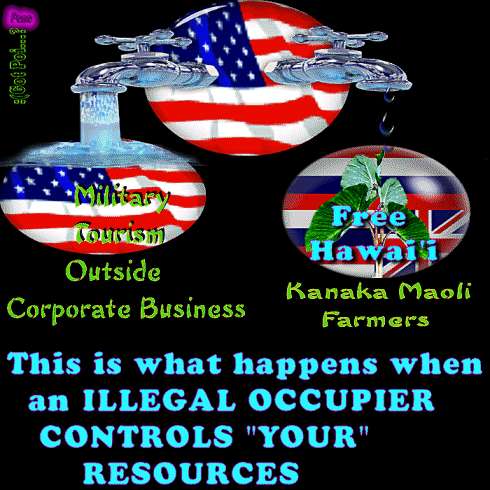
Associated Press
Sugar plantation, Native Hawaiians in water battle
By AUDREY McAVOY , 05.09.10, 09:15 PM EDTHAIKU, Hawaii --
Lyn Scott's family has fished in Honopou stream for centuries and tapped its
water
to farm the Hawaiian staple taro on stone-lined terraces built by her
ancestors.
Up the road, Leonard Pagan helps run irrigation systems at Hawaii's last
sugar
plantation. He's the fourth generation of his family to work at Hawaiian
Commercial & Sugar Co., going back to his great-grandfather who
emigrated
from Puerto Rico.
Taro, fish and sugar are all central to Hawaii's rich history and identity. To
thrive
in this corner of Maui, however, they must all be nourished by the same
supply
of water. This has triggered an emotional struggle pitting one of Maui's
biggest
employers - the last representative of Hawaii's once-mighty "King Sugar"
-
against Native Hawaiians fighting to hang on to neglected ancient
traditions.
"They're fighting for their way of life and we're fighting for ours," said Wesley
Bissen,
a 30-year veteran machinist at the plantation, Hawaiian Commercial &
Sugar
Co.
The battle is now in it's ninth year, dating to 2001 when the Native
Hawaiian Legal
Corporation filed a petition asking the state to return water to East
Maui
streams.
In 2008, the state water commission ordered the sugar plantation to restore
water
to 8 streams - including Honopou. But Scott says her family's still not
getting
enough water to fish and farm taro like her ancestors. They're waiting
for the
water commission to respond to a complaint filed by her lawyers.
Scott's counterparts further east along the coast are waiting another decision
from the
water commission in a case that seeks to force the sugar plantation to
restore
water to 19 additional East Maui streams.
HC&S has agreed to restore water to one of the 19 streams. But officials say
the
company would have to shut down if it's ordered to give up more,
sparking mass
layoffs.
"It might be a big company that is controlling the water but it employs 800
little
people. And that makes a big difference," said Pagan, whose family has
worked
for HC&S since the 1800s.
The water commission is expected to announce its decision on the 19 streams
this
month.
One possible compromise, said Chris Benjamin, HC&S general manager,
would have
the plantation restore some water to the streams during the winter while
holding
on to its current diversions during the summer. He said this would allow
the
plantation to continue to access East Maui water when it needs it the
most.
Benjamin said it's hard to say how HC&S would respond if the commission ruled
against
it. "It would depend on what they decide to do."
Sugar plantations began diverting water from the streams running through the
lush
hills and valleys of East Maui in 1876.
Whaling, Hawaii's economic mainstay at the time, was on the decline. Looking for a
new
source of growth, the Hawaiian Kingdom threw its support behind the
nascent
sugar industry. It gave the plantations permission to divert water from
wetter
sides of the Hawaiian islands and channel it to drier plains planted
with
sugarcane.
Sugar prospered across the state, giving plantation owners a prominent role in
running
Hawaii after the U.S.-backed overthrow of the monarchy until statehood
and the
emergence of tourism as an economic force.
On Maui, the legacy of water diversion lives on in 24 miles of ditches and
50 miles
of tunnels that funnel millions of gallons of water each day from East
Maui to
HC&S' vast fields in Central Maui.
Scott, 50, grew up seeing taro sprouting from small patches on her family's
land at the
end of a long, winding dirt road off Maui's Hana Highway.
But the family is now only able to farm nine patches - less than a quarter
of the 40
their ancestors cultivated - because there's not enough water coming
through
Honopou stream. The limited flow stunts the taro's growth, making them
prone to
disease.
Taro is perhaps the most important crop in Hawaiian culture - considered a
relative
and a food staple.
It's used to make poi, a standard part of the traditional diet. And,
according to
legend, the taro plant and the boy who became the first human were born
of the
same parents. This means taro and humans share ancestors in Hawaiian
tradition.
Scott wants her grandchildren to grow up around taro like she did. She says it
will
help them learn who they are, where they come from and grow up proud to
be
Hawaiian.
It's also important her grandchildren are able fish for crabs and fish in the
streams
and ocean like their ancestors. But she says the low water flow means
the fish
aren't plentiful.
"There goes our culture. How are we going to teach our children how to fish if
the fish
aren't there?" Scott said.
Native Hawaiians owning land along the 19 streams awaiting the water
commission's
decision also want to fish.
"Our clients are unable to engage in what was traditionally and customarily
done in
that area," said Moses Haia, another attorney with the Native Hawaiian
corporation. "It's what makes them who they are."
Benjamin, the HC&S general manager, said water commission staff have indicated
the
streams have healthy populations and no species is listed as endangered.
He said restoring water to the streams would help fish populations recover,
but he
urged people to weigh this against the loss of 800 HC&S jobs paying
an
average of $50,000 per year. He warned a plantation's closure would
reverberate
through Maui, where HC&S is one of the largest employers.
"The adverse impact to the public of that would far outweigh any benefit
that's going
to occur as a result of letting water flow to the ocean," Benjamin said.


Comments